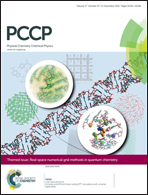Effect of salts on the solubility of ionic liquids in water: experimental and electrolyte Perturbed-Chain Statistical Associating Fluid Theory†
Abstract
Due to scarce available experimental data, as well as due to the absence of predictive models, the influence of salts on the solubility of ionic liquids (ILs) in water is still poorly understood. To this end, this work addresses the solubility of the IL 1-butyl-3-methylimidazolium bis(trifluoromethylsulfonyl)imide ([C4C1im][NTf2]), at 298.15 K and 0.1 MPa, in aqueous salt solutions (from 0.1 to 1.5 mol kg−1). At salt molalities higher than 0.2 mol kg−1, all salts caused salting-out of [C4C1im][NTf2] from aqueous solution with their strength decreasing in the following order: Al2(SO4)3 > ZnSO4 > K3C6H5O7 > KNaC4H4O6 > K3PO4 > Mg(CH3CO2)2 > K2HPO4 > MgSO4 > KH2PO4 > KCH3CO2. Some of these salts lead however to the salting-in of [C4C1im][NTf2] in aqueous medium at salt molalities lower than 0.2 mol kg−1. To attempt the development of a model able to describe the salt effects, comprising both the salting-in and salting-out phenomena observed, the electrolyte Perturbed-Chain Statistical Associating Fluid Theory (ePC-SAFT) was applied using ion-specific parameters. The gathered experimental data was modelled using ePC-SAFT parameters complemented by fitting a single binary parameter between K+ and the IL-ions to the IL solubility in K3PO4 aqueous solutions. Based on this approach, the description of anion-specific salting-out effects of the remaining potassium salts was found to be in good agreement with experimental data. Remarkably, ePC-SAFT is even able to predict the salting-in effect induced by K2HPO4, based on the single K+/IL-ions binary parameter which was fitted to an exclusively salting-out effect promoted by K3PO4. Finally, ePC-SAFT was applied to predict the influence of other sodium salts on the [C4C1im][NTf2] solubility in water, with experimental data taken from literature, leading to an excellent description of the liquid–liquid phase behaviour.


 Please wait while we load your content...
Please wait while we load your content...